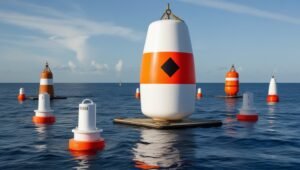
Understanding the Importance of Buoys in Water Navigation: A Comprehensive Guide
In the realm of maritime navigation, buoys play an important role in ensuring safety and guiding ships through various waterways. A common sight for mariners is a white buoy with an orange band and an orange diamond. Understanding the importance of that particular buoy to maintain safety on the water, along with appropriate measures to counter it.

What is a buoy and why is it important?
A buoy is a floating device that acts as a marker or signal in navigable waters. These devices are anchored to the seabed and are used for a variety of purposes, including marking channels, indicating the presence of hazards, and aiding navigation. The International Association of Marine Aids to Navigation and Lighthouse Authorities (IALA) sets standards for navigation systems worldwide, ensuring consistency and safety in maritime operations.
Types of Buoys and their functions
Buoys come in a variety of shapes, colors, and markings, each with a specific purpose. The most common types of buoys include.
Lateral Buoys: These mark the sides of waterways and indicate safe passage for ships.
Cardinal Buoys: These indicate the direction of safe water based on the cardinal directions (north, east, south, and west).
Special markers: These buoys are used to mark special features or areas, such as military exercise zones or pipelines.
Isolated Hazard Signs: These mark isolated hazards, such as submerged rocks, that are safe to pass on either side.
Among these, a white buoy with an orange band and an orange diamond falls under the category of regulatory buoys, which are specially designed to convey important information to mariners.
Significance of white buoy with orange band and orange diamond
Understanding the signs
A white buoy with an orange band and orange diamond is a regulatory buoy that indicates danger or warns of specific restrictions. The orange diamond on the buoy usually includes black letters or symbols, which provide additional information or instructions. This type of buoy is used in a variety of settings, including lakes, rivers, and coastal waters, to convey important information to boaters.

Orange Diamond Meaning
An orange diamond on this buoy is a caution sign. It is used to warn ships of potential impending dangers, such as reefs, shoals, reefs, or other underwater hazards. The orange bands on the buoy serve to make it highly visible, ensuring that boaters can see it from a distance, even in poor weather conditions.
Actions to take when you see this buoy
When you encounter a white buoy with orange bands and an orange diamond, it is important to take immediate and appropriate action to ensure your safety and the safety of others on the water. Here are the steps you should follow:
Slow down As soon as you see this buoy, slow down. The presence of an orange diamond indicates potential future danger, and it is important to proceed with caution.
Read the instructions Look carefully at the buoy and read any instructions or warnings displayed inside the orange diamond. This information will guide you regarding the specific nature of the hazard and the necessary precautions.
Avoid Danger Based on the information provided by the buoy, steer your vessel away from danger. This may include changing your course or slowing down further to ensure a safe passage.
Stay Alert Even after passing a buoy, be alert for other potential hazards or buoys that may indicate additional hazards.
Common locations where you might encounter this buoy.
Regulatory buoys such as white buoys with orange bands and orange diamonds are often found in areas where there are specific navigational hazards or restrictions. Common locations include:
Shallow Water These buoys are often used to mark shallow areas where ships may run aground.
Rocky Shores In coastal areas, they warn of submerged rocks or reefs that are a hazard to navigation.
Restricted Zones These buoys may also mark areas with speed restrictions, no-wake zones, or other regulatory measures.
Legal and safety implications of neglecting boys
Failure to follow buoys, especially orange diamond warnings, can have serious legal and safety consequences. Ignoring these signals can lead to accidents, damage to the vessel, or even loss of life. Additionally, maritime laws often impose penalties for boaters who ignore navigational aid, including fines or suspension of boating privileges.
Best practices for navigating safely around buoys
To ensure safe navigation in areas marked by buoys, it is important to follow these best practices:
Always keep updated charts: Nautical charts provide detailed information about the locations of buoys and other navigational aids. Keeping your charts updated ensures that you are aware of all potential hazards in your area.
Use GPS and AIS Advanced navigation systems, such as GPS and Automatic Identification Systems (AIS), can help you track your position relative to buoys and other vessels. These tools are invaluable for maintaining situational awareness of the water.
Keep a proper lookout Always be on the lookout for buoys, especially in unfamiliar or crowded waters. Assigning a crew member to search for marine assistance can prevent accidents.
Observe weather conditions Poor visibility due to fog, rain, or darkness can make it difficult to see the buoy. In such situations, reduce your speed and use your ship’s radar and other sensors to navigate safely.
Follow local regulations Different regions may have specific rules regarding buoyancy systems and navigation methods. Familiarize yourself with local regulations and follow them to avoid fines and ensure safety.

The result
Buoys, such as white buoys with orange bands and orange diamonds, are essential tools in marine navigation. They provide vital information that helps ships avoid hazards and navigate safely. By understanding the meaning of these buoys and taking appropriate actions when encountering them, boaters can significantly reduce the risk of accidents and ensure safe travel on the water.

1 What does the white buoy with the orange band and orange diamond signify?
This buoy indicates a potential hazard in the water, such as rocks or shallow areas, and warns boaters to proceed with caution.
2 What should you do when you see an orange diamond buoy?
You should slow down, read the instructions on the buoy carefully, and steer clear of danger to ensure a safe passage.
3Why is it important to pay attention to orange diamond buoys while sailing?
It is important to pay attention to these buoys as they mark dangerous areas that could damage your vessel or pose safety hazards if ignored.
